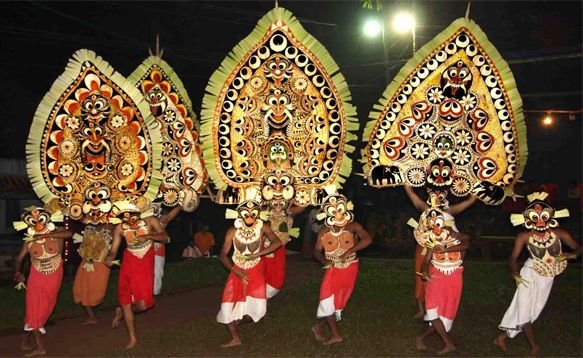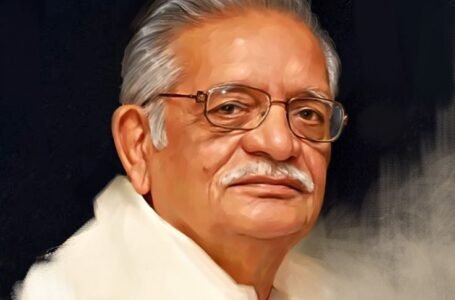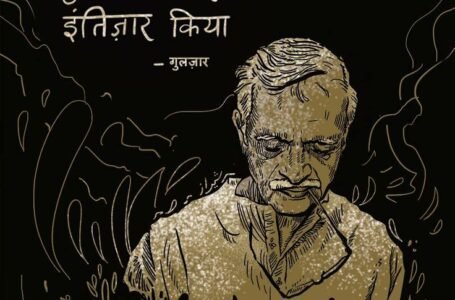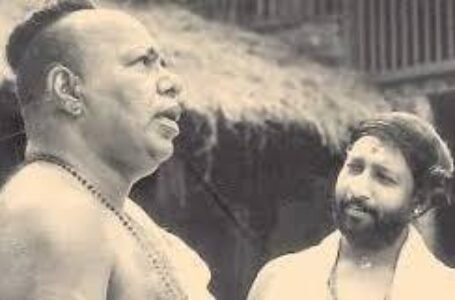Padayani (Kerala): A Sacred Ritual Dance Honoring Goddess Bhadrakali
- Ancient history Asian history
 Jayshree Waghela
Jayshree Waghela- February 24, 2025
- 0
- 8

Padayani, also known as Padeni, is one of the most vibrant and ancient ritualistic art forms of Kerala. The word ‘Padayani’ originates from the Malayalam words “Pata”, meaning military, and “Ani”, meaning formation or preparation—together symbolizing a ‘row of warriors.’ This ceremonial dance is deeply rooted in the cultural and spiritual practices of the central Travancore region of Kerala, particularly in the districts of Pathanamthitta, Kottayam, Kollam, and Alappuzha.
Traditionally performed in Bhagavati temples, Padayani is a unique blend of dance, music, theatre, satire, and elaborate masks. It is an offering to Goddess Bhadrakali, believed to be a fierce form of the goddess created to defeat the demon Darika. Over centuries, this ritual has evolved from a form of spiritual healing into a theatrical spectacle that reflects the rich folklore and spiritual essence of Kerala.
Historical Origins and Evolution of Padayani
The origins of Padayani trace back to the Dravidian culture that existed before the influence of Brahmanism in southern India. Historical records, including the Talakkad inscription of 1024 CE, mention the practice of Padayani, highlighting its ancient roots. This inscription refers to a tax collected by the village temple council and the Chera king Rajasimha from Christian traders in the Manigramam settlement to fund Padayani festivals. This early reference underscores the ritual’s importance in community life and temple worship.
Originally, Padayani emerged as a form of Kolam Thullal, a healing ritual performed by the Tinta sub-sect of the Ganaka community. Kolam Thullal was practiced as a method of exorcism and spiritual healing, believed to cure psychological and emotional disturbances that did not respond to conventional medical treatments. This ritual eventually evolved into the more elaborate and artistic form known as Padayani, becoming a vital part of Bhadrakali temple festivals.
Another perspective on its origins connects Padayani to martial arts traditions in Kerala. Given the term’s association with military formations, some scholars suggest that Padayani may have evolved from Kalari (martial arts) practices. In this interpretation, the dance symbolizes the parade of Nair soldiers and their Kalari Asaans (martial arts masters). Over time, the ritual was formalized and divided among different communities: Nairs became the principal performers, while the Kaniyar community took charge of writing lyrics and crafting elaborate masks.
Ritual Significance and Spiritual Dimensions
Padayani is more than a performance—it is an offering to Goddess Bhadrakali, meant to appease her and seek her blessings for protection and prosperity. The dance symbolizes the goddess’s victory over evil forces, particularly her triumph over Darika, as described in Hindu mythology.
The ritual cycle of Padayani typically lasts for several days, culminating in the grand Pooppada, a ceremonial conclusion marked by prayers for universal welfare. The final day of the festival is significant, as it signifies the end of the colorful celebrations and a return to everyday life, with devotees carrying the memory of the goddess’s blessings and protection.
One of the most elaborate Padayani performances takes place at the Puthukulangara Devi Temple in Othera, Pathanamthitta District. The highlight of this event is the Bhairavi Kolam, a massive and intricately crafted mask representing Goddess Bhadrakali, created using 1001 areca palm barks. This majestic display takes place on the festival’s final day, leaving a profound impression on all who witness it.
Performance Elements: Dance, Music, and Masks
Padayani is a visually stunning and acoustically rich performance. It incorporates multiple artistic elements, including music, dance, storytelling, and costume design. The central focus is on the Kolam, or decorative masks, which symbolize various divine and mythological figures. These masks are made from natural materials like areca palm leaves and are painted with vibrant, natural colors. Each mask represents a different deity or mythological figure, ranging from Bhadrakali to Yakshi (celestial nymphs) and Kalan (Lord of Death).
The dance Is performed by trained male performers who move rhythmically while wearing these elaborate Kolams. Their performance is accompanied by a distinctive set of percussion instruments, including:
Patayani Thappu – a large drum unique to the Padayani tradition.
Chenda – a cylindrical drum used in many South Indian temple rituals.
Para – a smaller, barrel-shaped drum.
Kumbham – a pot-like percussion instrument adding texture to the music.
The synchronized movements of the performers, combined with the pounding rhythm of these instruments, create an otherworldly atmosphere. The performers reenact stories from Hindu mythology, particularly the cosmic battle between Bhadrakali and Darika. Each Kolam has unique characteristics that dictate specific dance movements and emotional expressions.
Variations and Regional Practices
Although Padayani is most closely associated with the Pathanamthitta District, it is also performed in other regions of Kerala, including Kottayam, Kollam, and Alappuzha. While the core elements remain consistent, each region has developed its distinctive variations. For example:
Bhairavi Kolam at Puthukulangara Devi Temple is one of the most iconic forms, involving the creation of a massive and intricately detailed mask.
Kadammanitta Padayani is known for its poetic richness and literary influences, particularly due to the contributions of the poet Kadammanitta Ramakrishnan.
Modern Revival and Cultural Significance
Despite its deep cultural roots, Padayani has faced the threat of decline due to changing social and economic conditions. In response, efforts to preserve and promote this unique art form have intensified.
One major initiative was the creation of the Padayani Village in Kadammanitta, established in 2010. This cultural hub aims to keep the tradition alive through educational programs, performances, and museums dedicated to Padayani. The village serves as a center for both practitioners and scholars, ensuring that this ritual art remains a living tradition.
Additionally, Padayani has entered popular culture through films like “Pachathappu,” the first Malayalam film based on Padayani. Written and directed by Anu Purushoth, the film received recognition at the Kerala Film Critics Awards in 2020, bringing wider attention to the art form.
Padayani in Contemporary Context
Today, Padayani continues to be performed at various temples, but its frequency and scale have diminished. Modern adaptations include performances at weddings, cultural festivals, and tourist events, which reflect both the evolving nature of the tradition and efforts to sustain it.
However, Padayani remains a deeply sacred and spiritual practice. For many, it is not merely a performance but a ritual connection to the divine, embodying a collective plea for well-being, prosperity, and protection. The performance ends with a prayer for the wellness of the entire world, a poignant reminder of its communal and spiritual essence.
Conclusion: Preserving a Living Tradition
Padayani is more than just a ritual dance—it is a cultural treasure that reflects the spiritual, artistic, and communal life of Kerala. Its blend of mythology, music, and performance offers a unique glimpse into the region’s Dravidian heritage and sacred traditions.
Efforts to preserve and revitalize Padayani are crucial in ensuring that this ancient art form continues to thrive. Through cultural initiatives, scholarly research, and public performances, Padayani remains a living link to Kerala’s rich and diverse cultural heritage, inviting future generations to experience its profound beauty and spiritual power.


